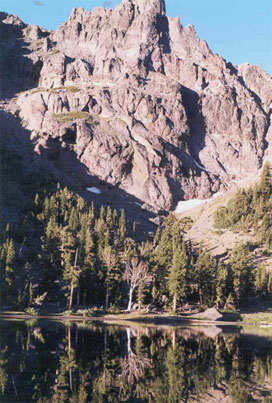Carson-Iceberg Wilderness
| Carson-Iceberg Wilderness | |
|---|---|
 |
|
| Location | Alpine County / Tuolumne County, Sierra Nevada Mountain range, California |
| Nearest city | Markleeville, California |
| Coordinates | 38°27′02″N 119°44′57″W / 38.45056°N 119.74917°WCoordinates: 38°27′02″N 119°44′57″W / 38.45056°N 119.74917°W |
| Area | 160,000 acres (650 km2) |
| Established | 1984 |
| Governing body | U.S. Forest Service / USDA |
The Carson-Iceberg Wilderness is a federal wilderness area located 80 miles (130 km) northeast of . It encompasses 160,000 acres (650 km2) and was designated by the California Wilderness Act of 1984. It protects an area of High Sierra landscape with elevations from 4,800 feet (1,500 m) to 11,462 feet (3,494 m) along the Sierra Mountains from Ebbetts Pass to Sonora Pass in the south. The US Forest Service manages the wilderness which is in both the Stanislaus National Forest and the Humboldt-Toiyabe National Forest. Located in the wilderness are the headwaters of the Carson River draining the east side of the crest, as well as the North and Middle Forks of the Stanislaus River on the west slopes.
The name Carson-Iceberg comes from two prominent geographical features: the Carson River (named for noted scout and explorer Kit Carson) and the distinctive granite formation called "The Iceberg" on the southern boundary near Clark Fork Road.
Historical highlights: Jedediah Smith crossed the Sierra Nevada Range near Ebbetts Pass sometime in 1827, and the first immigrant party of Bartleson-Bidwell crossed over in 1841 near Sonora Pass.
The wilderness supports large herds of mule deer and there is also good habitat for black bear, which have become a problem due to an insatiable appetite for backpackers' food. The forest cover consists of lodgepole pine, Jeffrey pine, aspen, Sierra juniper and curl-leaf mountain mahogany.
The Carson-Iceberg Wilderness supports a native population of the only Paiute cutthroat trout in existence in the drainages of Silver King Creek, a tributary of the East Fork Carson River. They were listed as endangered under the Endangered Species Preservation Act of 1966 and upgraded to threatened status in 1973 with the passage of the Endangered Species Act (ESA) which allowed regulated fishing of the Paiute. Historically, the US Fish and Wildlife Service believe the Paiute trout only occupied the Silver King Creek and its tributaries below the barrier of LLewellyn Falls, and around 1912 were introduced to other streams where the Paiute hybridized with the Lahonton and rainbow trout species.
...
Wikipedia
